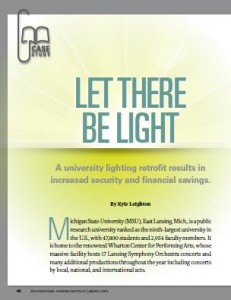Michigan State University (MSU), East Lansing, Mich., is a public research university ranked as the ninth-largest university in the U.S., with 47,800 students and 2,954 faculty members. It is home to the renowned Wharton Center for Performing Arts, whose massive facility hosts 17 Lansing Symphony Orchestra concerts and many additional productions throughout the year including concerts by local, national, and international acts.
Over the past few years, the university has adopted a strong on-campus sustainability initiative. Adopting these standards for energy savings requires a challenging operating specification to follow, and MSU launched a major lighting overhaul in the parking garage at the Wharton Center last fall.
Challenges and Solutions
Due to the demands of the indoor parking garage and the imminent scheduling of events, the criteria for indoor lighting were very stringent. Facility managers at the Wharton Center were concerned about light levels, dimming capabilities, installation deadlines, reliability, and procuring a fixture that would meet the energy reduction and U.S.-made requirements of Consumers Energy (the local utility) rebate programs.
One of the first decisions university officials made was to install parking garage luminaires that automatically reduce to 50 percent power on vacancy and increase to 100 percent power on occupancy, using a fixture- integrated occupancy sensor. These bi-level products can be combined with traditional photocontrols to maximize energy savings, which is estimated to be 30 to 50 percent per fixture.
“Bi-level lighting technologies for parking lots and parking structures is one of the most effective strategies for deep energy savings as well as for the potential to enhance safety and security,” says University of California Davis (UC Davis) Professor Michael Siminovitch, director of the California Lighting Technology Center (CLTC) of the University of California. “Bi-level lighting technologies can offer the facility manager significant savings while enhancing safety and security. At UC Davis, we have deployed a wide variety of bi-level induction systems including surface lot and parking structure applications. We have found that bi-level lighting technology can produce very significant savings while at the same time enhancing safety and security across the campus. This strategy has proven to be so effective in a broad cross-section of demonstrations that the state of California has integrated bi-level lighting into the 2014 title 24 code, requiring it for all major renovations and new construction.”
Most parking garages use high-intensity discharge light sources that operate continuously regardless of lighting needs. These facilities typically do not employ energy-saving control strategies such as daylighting or time clock scheduling, and no considerations are made for lighting control based on occupancy. Garage lighting, designed to only a single static level, wastes energy and contributes to peak demand during the day and light pollution.
The Retrofit
In late 2012, MSU moved forward with the advanced lighting fixtures and replaced 480 high-pressure sodium 175 watt fixtures with 70 watt EverLast® Bi-Level Davenport garage fixtures in the Wharton Center parking garage. The cost of such bi-level induction luminaires is generally one to two times higher than more common garage luminaires. The payback in most cases is estimated at between three and seven years, depending on occupancy rates and the size of the installation.
The fixtures chosen by MSU step down the energy use in the campus parking garage to 40 percent when areas are vacant for a set length of time, allowing the facility to achieve more than 60 percent energy savings when compared to existing fixtures. Furthermore, safety in the garage is also expected to improve; when the motion is detected and the higher light mode is activated, the change in visual environment alerts occupants.
“The goal of the center was to marry innovation, research, and product development in the academic world with the private sector. The collaboration that took place between CLTC and EverLast® from a design and development standpoint resulted in the bi-level induction parking garage fixture; the first of its kind. The fixture combined the energy-efficient features of an induction lamp with the added value of SMART motion and daylight controlled dimming, and the results were astonishing. What happened next was truly the definition of a successful university/private sector relationship. Not only was the center critical in the design, they became our first customer,” says Brandon Marken, vice president of sales, EverLast® Lighting. “University officials also found that safety increased, light quality increased, and the obvious goal of reducing energy consumption was met.”
One big benefit the university realized is that there are virtually no maintenance costs for up to 15 years on the new fixtures. As a result, the Wharton Center can expect to realize an estimated annual energy savings of more than $52,000 a year.
MSU has replaced more than 1,000 fixtures to date, expanding on the program in the garage. Installations have ranged from the East and West Recreational Campus buildings, and the Corp Science Building. Projects have included bi-level parking garage fixtures, which not only save energy and enhance student safety, as well as high bay fixtures, which lower energy costs while providing an unmatched 100,000-hour-rated lamp life.
Kyle Leighton is public relations coordinator with Full Spectrum Solutions, Inc. He can be reached at kyle@fullspectrumsolutions.com or 517.783.3800.
TPP-2013-03-Let There Be Light

